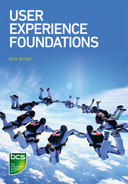This book introduces the professional discipline of user experience (UX) at a foundational level. It describes what UX professionals do, why they do it and why it works. The book is designed as a companion guide to the BCS Foundation Certificate in User Experience, and its structure is closely modelled on the certificate’s syllabus, available at: bcs.org/ux
As well as explaining the most important techniques and practices of UX, I discuss the field’s underlying principles, and we look at the ways in which UX fits in with other disciplines and project approaches.
This book is for anyone who wants to develop their understanding of user experience. People who will find this book useful might include:
- Experienced UX professionals who want to acquire the BCS Foundation Certificate in User Experience, and need a quick guide to its scope and philosophy.
- UX professionals at an early stage of their career who would value a clear and simple overview of the field.
- People at the beginning of their career who are considering UX as a career option.
- IT professionals who are currently working within a non-UX field of specialisation, such as software development, testing, business analysis or project management, and who are considering a move into UX.
- Non-IT professionals who are considering a move into UX.
- Non-UX IT professionals who are not considering a career move, but who would like to understand the field better so that they can work more effectively with UX specialists.
- Non-UX IT professionals who are not considering a career move, but who would like to extend and enrich their practice by learning about UX.
UX is a comparatively young discipline. Like other young disciplines, it is characterised by a lack of uniformity in principles, terminology and methods. To some extent this is a positive sign of a lively and diverse professional community that is constantly developing and reflecting on its practice. Sometimes, however, there is a risk that inexperienced readers will find themselves misled or confused by material on the web or elsewhere that repeats misconceptions and fallacies about UX, or which overstates partisan positions on certain issues. This book aims to provide readers with a solid base for the development of their knowledge about the field. In cases where there is doubt or disagreement, the book relies on the following sources, in order of decreasing importance:
- The definitions, principles and processes defined in international standards, especially ISO 9241-210 (2019) and ISO 9241-11 (2018).
- The concepts and terminology incorporated in the syllabus for the BCS Foundation Certificate in User Experience and in its associated exam questions.
- Generally accepted good practice in the professional UX community.
- The author’s own experience and opinions.
THE BCS FOUNDATION CERTIFICATE IN USER EXPERIENCE
In 2015, BCS, The Chartered Institute for IT, introduced a Foundation Certificate in User Experience.
The syllabus for the exam is available on the BCS website. It is organised into the following sections, with learning objectives for each:
- Guiding principles
- User research
- Illustrating the context of use
- Measuring usability
- Information architecture
- Interaction design
- Visual design
- User interface prototyping
- Usability evaluation
The organisation of this book from Chapters 3 to 11 follows this structure exactly. Additionally, supplementary chapters (1, 2 and 12) have been included at the beginning and end to provide some orientation and further useful information, particularly with a view to the needs of the groups of prospective readers mentioned above. For readers who are thinking of taking the Foundation Certificate exam, it is important to realise that the supplementary chapters do not form part of the syllabus and are not ‘examinable’. There are also some sections in Chapters 3 to 11 containing non-examinable material. These are clearly marked (see the ‘Visual cues in this book’ section, below).
The Appendix provides some more information on the Foundation Certificate examination. Appendix A1 describes the K level scheme, which governs the allocation of a specified level to each learning objective.
Each chapter starts with an introductory section indicating the topics covered, followed by a table that lists the learning objectives for the chapter as defined by the syllabus. Each learning objective is at one of three levels: Remember (the most basic), Understand or Apply (the most advanced). At the end of each examinable chapter are some sample questions, with answers and explanations.

There’s more to UX than what’s in this book!
Each section of the syllabus for the BCS Foundation Certificate in User Experience defines several learning objectives relating to the area in question. To maintain its focus, this book restricts itself to covering the subject matter of the given learning objectives for each area, and providing contextual information around them. In practice, the scope of each area is wider than is suggested by the learning objectives; the book therefore omits a great deal of information.
For example, the chapter on information architecture does not discuss search strategy in detail; the chapter on interaction design does not explore the range of input and output methods and devices that are currently available; and the chapter on visual design barely scratches the surface of practical graphic design. Arguably, there are some entire top-level areas that could have been added, on content design, for example.
The further reading section at the end of each chapter provides signposts to additional useful information.
INTERNATIONAL STANDARDS
As well as giving guidance on methods, international standards provide commonly agreed definitions of basic terms and concepts. We will use them as a reference point in this book to help us find our way through the sometimes conflicting or unclear terminology used by different practitioners.
ISO 9241
The most important standard in the field of user experience is ISO 9241, whose overall title is, at the time of writing, ‘Ergonomics of human-system interaction’. This is in fact a family of interrelated documents, each of which evolves over time. Many of them have been given new numbers in recent years, or will soon be given new numbers.
The two parts of ISO 9241 most relevant to this book are ISO 9241-210 (2019), ‘Human-Centred Design for Interactive Systems’, which sets out the principles and process described in Chapter 3, and ISO 9241-11 (2018), ‘Usability: definitions and concepts’, which contains operational definitions of usability and its components. We will also refer to several other standards from the International Organization for Standardization (ISO) and other bodies in passing.
Terms defined in the Glossary
Where a word other than a heading or subheading is printed as bold text in this book, this means that the term is defined in the Glossary.
Boxes
On many pages you will see ‘box-outs’, shaded areas with an icon in the margin. The intention of the box-outs is to draw your attention to particularly important points. The icons are used as follows:

Golden Rule
An important UX rule or principle that you need to know in order to achieve the BCS Foundation Certificate in UX.

Definition
A definition that you need to know in order to achieve the BCS Foundation Certificate in UX. The definitions are all contained in the Glossary, but some of the most important are repeated in the main body of the book.

Bright Idea
A particularly noteworthy practical tip.

Danger
This alerts you to a possible misconception that could cause confusion. These are often to do with potentially misleading use of terminology. Special attention is paid to ‘false friends’ – terms that may be familiar to readers from other contexts, but which are used in a different sense in UX.

Remember
Something you need to pay attention to in order to get the best out of the book.

Extra information
Information that you do not need to know in order to achieve the BCS Foundation Certificate in UX. This material supplements the syllabus but does not form part of it.
REFERENCES
ISO 9241-11:2018 (2018) Ergonomics of Human-System Interaction – Part 11: Usability: Definitions and Concepts. International Organization for Standardization (ISO), Geneva.
ISO 9241-210:2019 (2019) Ergonomics of Human-System Interaction – Part 210: Human-Centred Design for Interactive Systems. International Organization for Standardization (ISO), Geneva.
Halvorson, K. and Rach, M. (2012) Content Strategy for the Web, 2nd edn. New Riders, Berkeley, CA.
Kortum, P. (2008) HCI beyond the GUI: Design for Haptic, Speech, Olfactory, and Other Nontraditional Interfaces. Elsevier, Burlington, MA.
Redish, J.G. (2012) Letting Go of the Words: Writing Web Content that Works. Morgan Kaufmann, San Francisco, CA.
